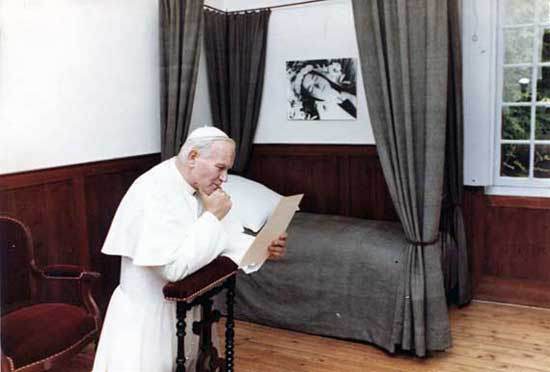Saint John Paul II declared only one “Doctor of the Church” during his twenty-six year pontificate. He canonized a total of 480 men and women and yet he only held up one saint as a prime example of holiness and teaching. That saint was not an accomplished academic or high-ranking ecclesiastic. Instead, it was the “Little Flower,” Saint Thérèse of Lisieux.
[featured-image single_newwindow=”false”]
Saint Thérèse’s autobiography The Story of a Soul was first published in French on September 30, 1898, a year after her death. It did not take long for her inspiring story to be translated into numerous languages, with the first Polish edition published in 1902. Father Raphael Kalinowski, a Carmelite friar in Poland, translated it. John Paul II greatly admired Father Kalinowski and eventually canonized him in 1991.
Throughout his pontificate, John Paul II sought ways to honor this simple and humble nun from France. Shortly after becoming pope, he made a special trip to Lisieux in 1980 and visited the various sites of Saint Thérèse’s life. Several years later in 1994, John Paul II declared her parents “venerable,” and praised them for their beautiful lives of holiness.
Doctor of Divine Love
Then in 1997, John Paul II declared her a “Doctor of the Church.” Saint Thérèse became both the third woman and youngest saint to be named a “Doctor.” John Paul II praised the “Little Flower” for her beautiful teachings on “divine love.” Even though she never received any great theological training, John Paul II noted that Saint Thérèse”possesses an extraordinary wisdom and with her doctrine helps so many men and women of every state in life to know and love Jesus Christ and his Gospel” (Divini Amoris Scientia, 4).
Saint Thérèse, John Paul II points out, “counters a rational culture, so often overcome by practical materialism, with the disarming simplicity of the “little way” which, by returning to the essentials, leads to the secret of all life: the divine Love that surrounds and penetrates every human venture” (Homily of John Paul II). What is so fascinating about her life and teachings is that the “little way” is accessible to anyone, in any state of life. It is a pathway to Christ “not that of the great undertakings reserved for the few, but on the contrary, a way within everyone’s reach” (Homily of John Paul II).
John Paul II even noted that her teachings in regards to the “the mystery and journey of the Virgin Mary” were able to achieve “results very close to the doctrine of the Second Vatican Council in chapter eight of the Constitution Lumen Gentium and to what I myself taught in the Encyclical Letter Redemptoris Mater (Divini Amoris Scientia, 8). In many ways she was ahead of her times.
An Example for us all
In the end, John Paul II was very deliberate when he chose to raise someone to the rank of “Doctor of the Church.” He even pointed out this intentionality during his homily when she was named a “Doctor:”
when the Magisterium proclaims someone a Doctor of the Church, it intends to point out to all the faithful, particularly to those who perform in the Church the fundamental service of preaching or who undertake the delicate task of theological teaching and research, that the doctrine professed and proclaimed by a certain person can be a reference point, not only because it conforms to revealed truth, but also because it sheds new light on the mysteries of the faith, a deeper understanding of Christ’s mystery. (Homily of John Paul II)
Saint Thérèse is a great saint, one worthy of imitation. John Paul II knew this and took her as a model for his own life as well. He points her out to us and with good reason. John Paul II boldly proclaims:
In a time like ours, so frequently marked by an ephemeral and hedonistic culture, this new Doctor of the Church proves to be remarkably effective in enlightening the mind and heart of those who hunger and thirst for truth and love. An eminent model and guide for Christians today.
Saint Thérèse, pray for us!

